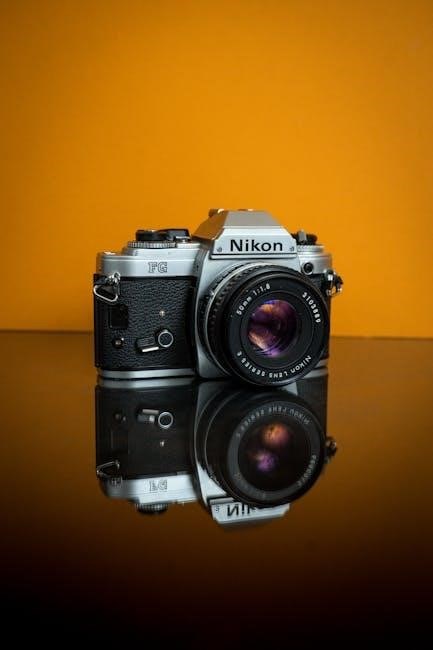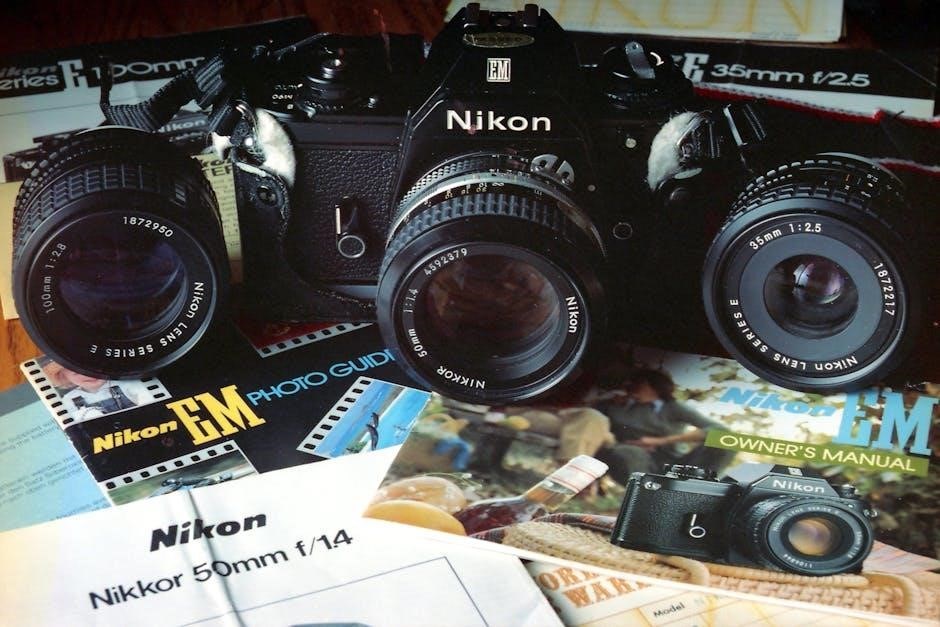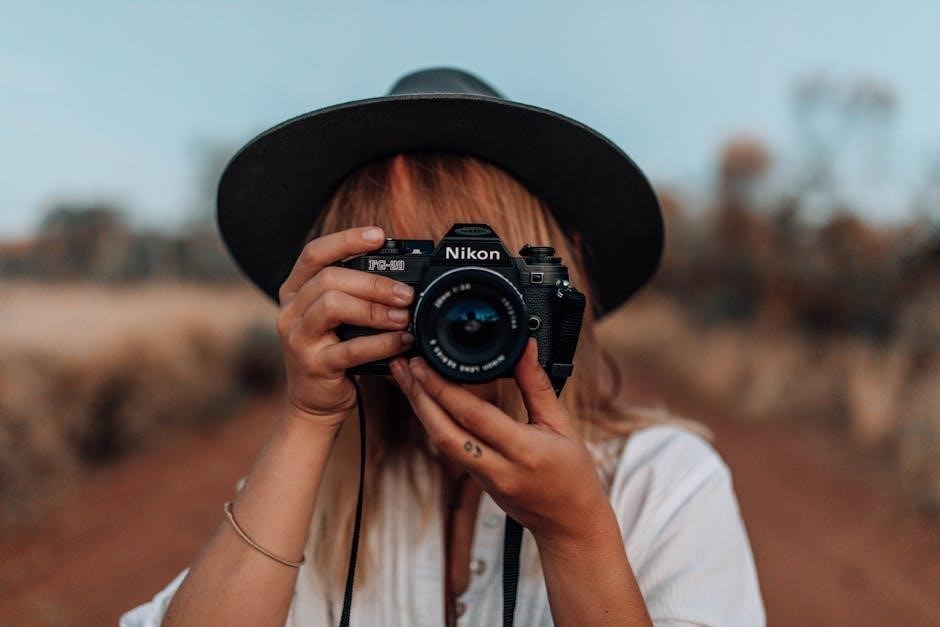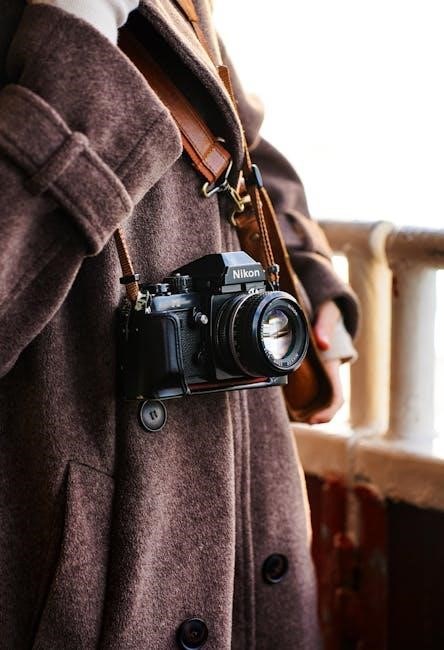
nikon d3400 owner’s manual
The Nikon D3400 is a versatile and user-friendly DSLR camera designed for beginners and hobbyists. Released in 2016, it features a 24.2MP APS-C sensor, EXPEED 4 processor, and SnapBridge connectivity. This guide helps you master its features and settings for stunning photography.
Overview of the D3400’s Key Features
The Nikon D3400 is a feature-rich DSLR camera designed to deliver high-quality images and user-friendly operation. It boasts a 24.2-megapixel APS-C CMOS sensor, which captures detailed photos with excellent color accuracy. The camera is powered by Nikon’s EXPEED 4 image processor, ensuring fast performance and efficient noise reduction. Weighing just 395 grams, the D3400 is lightweight and compact, making it ideal for travel and everyday photography. It features an 11-point autofocus system for precise subject tracking and a wide ISO range of 100-25600, allowing for flexible shooting in various lighting conditions. The camera also includes a 3-inch LCD screen for image preview and playback, though it is not touch-sensitive or articulated. Video recording capabilities include 1080p at 60fps, making it suitable for casual videography. Additionally, the D3400 supports wireless connectivity via Bluetooth through Nikon’s SnapBridge app, enabling seamless image transfer to smartphones. With a variety of shooting modes, including Guide Mode for beginners, and compatibility with Nikon’s extensive range of lenses, the D3400 is a versatile tool for photographers of all skill levels.
Importance of Reading the Manual
Reading the Nikon D3400 owner’s manual is essential for unlocking the camera’s full potential and optimizing your photography experience. The manual provides a comprehensive guide to understanding the camera’s features, settings, and modes, ensuring you make the most of its capabilities. It covers detailed explanations of the 24.2MP APS-C sensor, EXPEED 4 processor, and various shooting modes, helping you grasp how to use these tools effectively. Additionally, the manual includes troubleshooting tips and maintenance advice to keep your camera in optimal condition. Whether you’re a beginner or an experienced photographer, the manual offers insights into advanced techniques and custom settings that can enhance your creativity. It also highlights the importance of proper setup and configuration, such as charging the battery, inserting the memory card, and attaching the lens correctly. By familiarizing yourself with the manual, you can avoid common mistakes and ensure your camera performs at its best. The Nikon D3400 manual is available for download in PDF format, making it easily accessible for reference anytime, anywhere.

Camera Features and Specifications
The Nikon D3400 features a 24.2MP APS-C DX-format sensor, EXPEED 4 image processor, and 11 AF points for precise autofocus. It offers an ISO range of 100-25600, a 3-inch LCD screen, and Full HD video recording at 60fps, making it ideal for photography enthusiasts.
Image Sensor and Resolution
The Nikon D3400 is equipped with a 24.2-megapixel APS-C DX-format CMOS image sensor, designed to capture high-quality images with exceptional detail and clarity. This sensor is ideal for beginners and hobbyists, offering a balance between resolution and performance. The camera supports a wide range of image resolutions, including 6000 x 4000 pixels for still images, ensuring that your photos are sharp and vibrant. The sensor also works in conjunction with the EXPEED 4 image processor to deliver improved noise reduction and color accuracy, even in low-light conditions.
With a maximum resolution of 24.2 megapixels, the D3400 provides ample detail for cropping, enlarging, and printing photos. The camera also offers lower resolution settings, such as 4496 x 3000 pixels and 2992 x 2000 pixels, which are useful for sharing images online or reducing file sizes. Additionally, the D3400 supports the NEF (RAW) format, allowing for greater flexibility in post-processing. The combination of the sensor and processor ensures that images are captured with precise color reproduction and minimal noise, making the D3400 a reliable choice for photographers of all skill levels.
EXPEED 4 Image Processor
The Nikon D3400 is powered by the EXPEED 4 image processor, a high-performance engine designed to enhance image quality and processing speed. This processor plays a crucial role in delivering sharp, detailed images with accurate colors and reduced noise; It ensures that the camera can handle a wide range of shooting conditions, from bright daylight to low-light environments, with ease.

One of the key benefits of the EXPEED 4 processor is its ability to minimize noise, even at higher ISO settings. This makes it ideal for capturing images in dimly lit situations without compromising quality. Additionally, the processor supports advanced autofocus and metering systems, enabling faster and more precise subject tracking. It also enhances the camera’s overall responsiveness, allowing for smoother operation during continuous shooting and video recording.
The EXPEED 4 processor further contributes to the D3400’s energy efficiency, helping to extend battery life. It supports Full HD video recording at 1080p, ensuring smooth and detailed footage. With the EXPEED 4, the D3400 delivers a balance of speed, quality, and efficiency, making it a reliable choice for photographers of all levels. This processor is a cornerstone of the camera’s performance, enabling it to produce outstanding results in various photographic situations.

LCD Screen and Viewfinder
The Nikon D3400 features a 3-inch LCD screen with a resolution of 921,000 dots, providing clear and vibrant image playback, menu navigation, and access to camera settings. The screen is fixed and not touch-sensitive, but its high resolution ensures that images and text are displayed with sharpness and clarity. The LCD is also useful for reviewing photos, checking histograms, and adjusting settings on the fly.
The optical viewfinder is another essential feature of the D3400, offering a bright and accurate view of the scene. It provides 95% coverage of the frame, allowing photographers to preview their compositions effectively. The viewfinder’s magnification is 0.85x, making it comfortable to use for both eyeglass wearers and those without. The viewfinder also displays key shooting information, such as aperture, shutter speed, and ISO, helping photographers make quick adjustments without taking their eye off the scene.
While the viewfinder does not offer 100% coverage, it remains a reliable tool for precise framing and focusing, especially in bright lighting conditions where the LCD screen may be difficult to view. The combination of the LCD screen and optical viewfinder provides photographers with flexible options for composing and reviewing their images;
Connectivity Options
The Nikon D3400 offers a range of connectivity options to enhance your photography experience and streamline image sharing. One of its standout features is Bluetooth and Wi-Fi connectivity through Nikon’s SnapBridge app, allowing seamless transfer of images to smartphones, tablets, or computers. This feature is particularly useful for instantly sharing photos on social media or backing up your work.
The camera also supports direct printing to PictBridge-compatible printers, enabling you to print your photos without needing a computer. Additionally, the D3400 includes an HDMI output, making it easy to connect the camera to an HDTV or external monitor for reviewing photos or slideshows.
For remote shooting, the D3400 is compatible with the Nikon ML-L3 Wireless Remote Control, giving you the flexibility to take photos without physically touching the camera. This is especially handy for reducing camera shake during long exposures or group portraits. The camera also supports Nikon’s optional accessories, such as the MC-DC2 Remote Cord, for added control and convenience.
With these connectivity options, the Nikon D3400 ensures that you can easily share, print, and manage your photos while expanding your creative possibilities. Whether you’re at home, in the studio, or on the go, the camera’s versatile connectivity features make it a practical choice for photographers of all levels.

Initial Setup and Configuration
Setting up your Nikon D3400 begins with unboxing and first impressions, followed by charging the battery, inserting the memory card, and attaching the lens. Basic camera settings are then configured to ensure optimal performance. This process is essential for a smooth start with your photography journey.
Unboxing and First Impressions
Unboxing the Nikon D3400 is an exciting experience, as it comes neatly packaged with all essential accessories. The camera body, an AF-P DX NIKKOR 18-55mm f/3.5-5.6G VR lens, rechargeable Li-ion battery, charger, USB cable, and a neck strap are typically included. Upon first impressions, the D3400 feels lightweight and compact, making it easy to handle for photographers of all skill levels. The build quality is sturdy, with a comfortable grip that ensures stability while shooting. The camera’s design is intuitive, with controls and buttons strategically placed for easy access. Turning it on for the first time, you’ll notice the bright 3-inch LCD screen, which provides clear visuals for menu navigation and image preview. The initial setup guide, accessible through the menu, helps users familiarize themselves with the camera’s features. Many users have reported feeling a sense of excitement and readiness to explore the world of photography with this user-friendly DSLR. The D3400’s compact size and feature-rich interface make it an ideal choice for those looking to capture high-quality images right out of the box.
Charging the Battery
Charging the battery for your Nikon D3400 is a straightforward process that ensures you’re ready to capture memories without interruption. The camera comes with a rechargeable Li-ion battery (EN-EL14a) and a charger (MH-24). To begin, insert the battery into the charger, ensuring the terminals align correctly. Plug the charger into a power outlet and wait for the charging light to turn red, indicating the process has started. The light will turn green when the battery is fully charged, which typically takes about 2 hours. Avoid overcharging, as it can reduce the battery’s lifespan. Once charged, remove the battery from the charger and insert it into the camera, securing it properly. Always use the provided charger to prevent damage to the battery or camera. If the battery doesn’t charge, check for dirt on the terminals and clean them gently with a soft cloth. For optimal performance, update the camera’s firmware periodically, as Nikon releases improvements for battery management and overall functionality. Proper care of the battery ensures reliable performance and longevity for your D3400.
Inserting the Memory Card
Inserting the memory card into your Nikon D3400 is a crucial step to ensure your photos and videos are stored properly. Begin by locating the memory card slot on the right side of the camera. Open the compartment door by sliding it towards the back and lifting it up. Gently remove any existing card if necessary. Take your SD or SDHC memory card and align the gold contacts with those inside the slot, ensuring the label faces towards the camera; Push the card in until it clicks, confirming it’s securely locked in place. Close the compartment door firmly to protect the card from dust and accidental removal. Turn on the camera to verify the card is recognized by checking the available space in the setup menu. Always format the memory card in the camera before first use to maintain compatibility and prevent data errors; Avoid removing the card during data transfer to prevent corruption. Use high-quality, compatible memory cards recommended by Nikon for optimal performance and reliability. Properly inserting and managing your memory card ensures smooth operation and safeguards your captured moments.
Attaching the Lens
Attaching a lens to your Nikon D3400 is a straightforward process that requires care to ensure proper alignment and avoid damage. Start by locating the lens mount on the camera body, which is the circular opening with a white alignment mark. Hold the lens by the barrel, ensuring the rear element is clean and free of debris. Align the lens mount with the camera’s mount, matching the white dot on the lens to the white dot on the camera. Gently rotate the lens clockwise while applying light pressure until it clicks into place securely. Avoid forcing the lens, as this could damage the mount or the lens itself.
Once the lens is attached, give it a slight twist to ensure it is locked properly. Never touch the rear element of the lens or the camera’s sensor to prevent smudging or damage. Use only Nikon-compatible lenses or third-party lenses designed for the Nikon F-mount to ensure compatibility. Avoid using damaged or improperly fitted lenses, as they may cause mechanical or electrical issues. Always handle the lens and camera with clean, dry hands to maintain optimal performance and longevity. Properly attaching the lens ensures sharp, high-quality images and protects your equipment from potential harm.
Basic Camera Settings
Mastering the basic camera settings on your Nikon D3400 is essential for capturing high-quality images. Start by familiarizing yourself with the mode dial, which offers options like Auto, P (Program), S (Shutter Priority), A (Aperture Priority), and M (Manual). Auto mode is ideal for beginners, as it automatically adjusts settings for optimal results. For more control, use P mode, which allows adjustments while maintaining balanced exposure.

Aperture Priority (A) lets you set the aperture, while the camera adjusts the shutter speed. Shutter Priority (S) allows you to control the shutter speed, making it perfect for freezing or blurring motion. Manual (M) mode gives full control over both aperture and shutter speed for advanced photography. Scene Modes, such as Portrait, Landscape, and Night Portrait, are also available for specific shooting situations.
Adjust the ISO sensitivity to manage noise in low-light conditions. Lower ISOs (100-400) are best for bright lighting, while higher ISOs (6400-25600) are suitable for dim environments but may introduce noise. Focus modes like AF-A (auto-servo), AF-S (single-servo), and AF-C (continuous-servo) help capture sharp images. Use the self-timer or remote shutter release to avoid camera shake during tripod shooting. Experiment with these settings to enhance your photography skills and achieve desired effects. Properly configuring these basics ensures consistent and professional-looking results.

Shooting Modes Explained
The Nikon D3400 offers various shooting modes to enhance your photography experience. Auto Mode simplifies shooting, while Scene Modes and Special Effects provide creative control. These modes adapt to different conditions, helping you capture stunning images with ease and precision.
Auto Mode and Scene Selection
Auto Mode on the Nikon D3400 is designed for simplicity, allowing the camera to automatically adjust settings for optimal results. This mode is ideal for beginners or casual shooters who want to focus on composition without manual adjustments.
Scene Selection offers pre-programmed settings tailored to specific shooting situations, such as Portrait, Landscape, Close-Up, and Night Portrait. Each mode automatically adjusts parameters like aperture, shutter speed, and ISO to suit the scene, ensuring vibrant and well-balanced images.
For instance, Portrait mode emphasizes a shallow depth of field to blur backgrounds, while Landscape mode enhances sharpness and color saturation for scenic shots. Close-Up mode is perfect for macro photography, capturing fine details in textures and patterns.
By utilizing Auto Mode and Scene Selection, users can achieve professional-looking photos effortlessly, making these modes invaluable for those still learning the intricacies of manual photography.

Aperture, Shutter Priority, and Manual Modes

Aperture Priority (A/Av), Shutter Priority (S/Tv), and Manual (M) modes on the Nikon D3400 offer advanced control for photographers seeking creative freedom. In Aperture Priority, users set the aperture (f-stop) to control depth of field, while the camera automatically adjusts the shutter speed for proper exposure. This mode is ideal for portraits, where a shallow depth of field can blur backgrounds, or landscapes, where a wide depth of field keeps everything sharp.
Shutter Priority allows photographers to set the shutter speed, which is perfect for capturing motion effects, such as freezing fast-moving subjects or creating artistic blur. The camera then adjusts the aperture to maintain the correct exposure.
Manual Mode (M) provides full control over both aperture and shutter speed, enabling precise adjustments for specific lighting conditions. This mode is best for experienced users who want absolute control over their shots. To use these modes effectively, photographers should monitor the exposure compensation button (+/-) to fine-tune brightness and ensure balanced results. By mastering these modes, users can unlock the full creative potential of the D3400.
Understanding Scene Modes
The Nikon D3400 offers a variety of Scene Modes designed to optimize camera settings for specific shooting situations. These modes simplify photography for users by automatically adjusting aperture, shutter speed, and other settings to capture the best possible results. Common Scene Modes include Portrait, Landscape, Child, Sports, Close-up, and Night Portrait.
In Portrait mode, the camera emphasizes a shallow depth of field to blur backgrounds and highlight the subject’s face. Landscape mode prioritizes sharpness and detail across the entire frame, making it ideal for wide-angle shots. Sports mode freezes fast-moving subjects by using faster shutter speeds, while Close-up mode enhances detail in small objects like flowers or jewelry.
For low-light scenarios without a tripod, Night Portrait mode balances flash with ambient light to capture both the subject and background. The D3400 also includes an Effects tab for creative filters like Miniature Effect and Selective Color. Experimenting with these modes helps users achieve professional-looking results without manual adjustments. Always review your shots and adjust settings as needed for the best outcome.
Using Special Effects
The Nikon D3400 offers a range of Special Effects that allow users to add creative flair to their images directly in-camera. These effects can be applied during shooting, enabling photographers to preview the result before capturing the photo. The most popular effects include Miniature Effect, Selective Color, Silhouette, High Key, and Low Key.
The Miniature Effect creates a tilt-shift-like effect, making subjects appear like small-scale models by blurring the top and bottom of the frame. Selective Color isolates specific colors in the image while converting the rest to monochrome, ideal for emphasizing particular elements like flowers or clothing.
Silhouette mode is perfect for capturing dark outlines of subjects against bright backgrounds, such as backlit portraits or cityscapes. High Key and Low Key modes are designed for bright, even lighting and dramatic shadows, respectively. These effects are accessed through the camera’s mode dial, making it easy to experiment with different styles.
By leveraging these Special Effects, photographers can achieve unique and artistic results without post-processing software, making the D3400 a versatile tool for creative expression.

Autofocus Modes and Metering
The Nikon D3400 features advanced autofocus and metering systems to ensure sharp and well-exposed images. The camera offers 11 autofocus points, with a central cross-type sensor for enhanced accuracy. Autofocus modes include Single AF, Continuous AF, and Manual Focus.
Single AF is ideal for stationary subjects, locking focus quickly and precisely. Continuous AF is designed for moving subjects, adjusting focus as they move within the frame. Manual Focus allows users to take full control of focus for creative or macro photography.
For metering, the D3400 provides 3 modes: Matrix Metering, Center-Weighted Metering, and Spot Metering. Matrix Metering analyzes the entire scene for balanced exposure, while Center-Weighted Metering prioritizes the center of the frame. Spot Metering measures light from a small area, useful for high-contrast scenes.
These systems work together to help photographers achieve professional results, whether shooting portraits, landscapes, or dynamic action shots. Understanding and utilizing these modes effectively is key to unlocking the D3400’s full potential.